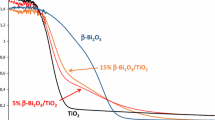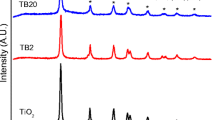Abstract
Titanium oxide is a common semiconductor used in heterogeneous photocatalysis. However, TiO2 efficiency is limited because TiO2 absorbs only a small fraction of visible light. An alternative would be to use bismuth oxide (Bi2O3) in association with TiO2 because Bi2O3 has a strong absorption in the visible light region. We have optimized the synthesis of α- and β-Bi2O3, drawing from the two main methods, namely precipitation and hydrothermal synthesis. The structural and light absorption properties of as-prepared composites were determined using different spectroscopic techniques (UV–Vis DRS and XRD). The photocatalytic activity of the β-Bi2O3 has been compared to commercial and prepared α-Bi2O3 for the photodegradation of Orange II under visible and UV light.



Similar content being viewed by others
References
Bessekhouad Y, Robert D, Weber JV (2005) Photocatalytic activity of Cu2O/TiO2, Bi2O3/TiO2 and ZnMn2O4/TiO2 heterojunctions. Catal Today 101:315–321
Carp O, Huisman CL, Reller A (2004) Photoinduced reactivity of titanium dioxide. Prog Solid State Chem 32–33:177–181
Gualtieri AF, Immovilli S, Prudenziati M (1997) Powder X-ray diffraction data for the new polymorphic compound ω-Bi2O3. Powder Diffr 12:90–92
He WD, Qin W, Wu XH, Ding XB, Chen L, Jiang ZH (2007) The photocatalytic properties of bismuth oxide films prepared through the sol–gel method. Thin Solid Films 515:5362–5365
Hoffman MR, Martin ST, Choi W, Bahnemann DW (1995) Environmental applications of semiconductor photocatalysis. Chem Rev 95:69–96
Hou J, Yang C, Wang Z, Zhou W, Jiao S, Zhu H (2013) In situ synthesis of α–β phase heterojunction on Bi2O3 nanowires with exceptional visible-light photocatalytic performance. Appl Catal B Environmental 142–143:504–511
Iyyapushpam S, Nishanthi ST, Pathinettam Padiyan D (2013) Photocatalytic degradation of methyl orange using a-Bi2O3 prepared without surfactant. J Alloys Compd 563:104–107
Li XZ, Li FB, Yang CL, Ge WK (2001) Photocatalytic activity of WOx–TiO2 under visible light irradiation. J Photochem Photobiol A Chem 141:209–217
Li D, Zhang Y, Zhang Y, Zhou X (2013) Fabrication of bidirectionally doped Bi2O3/TiO2-NTs with enhanced photocatalysis under visible light irradiation. Journal of hazardous materials 258–259:42–49
Malato S, Fernandez-Ibanez P, Maldonato MI, Blanco M, Gernjak W (2009) Decontamination and disinfection of water by solar photocatalysis: recent overview and trends. Catal Today 147:1–59
Robert D (2007) Photosensitization of TiO2 by MxOy and MxSy nanoparticles for heterogeneous photocatalysis applications. Catal Today 122:20–26
Sammes NM, Tompsett GA, Näfe H, Aldinger F (1999) Bismuth based oxide electrolytes—structure and ionic conductivity. J Eur Ceram Soc 19:1801–1826
Serpone N, Borgarello E, Grâtzel M (1984) Visible light induced generation of hydrogen from H2S in mixed semiconductor dispersions: improved efficiency through inter-particle electron transfer. J Chem Soc Chem Commun 6:342–344
Serpone N, Marathamuthu P, Pichat P, Pelizzetti E, Hidaka H (1995) Exploiting the interparticle electron transfer process in the photocatalysed oxidation of phenol, 2-chlorophenol and pentachlorophenol: chemical evidence for electron and hole transfer between coupled semiconductors. J Photochem Photobiol A Chem 85:247
Shchukin D, Poznyak S, Kulak A, Pichat P (2004) TiO2–In2O3 photocatalysts: preparation, characterisations and activity for 2-chlorophenol degradation in water. J Photochem Photobiol A Chem A162:423–430
Vinodgopal K, Kamat PV (1995) Enhanced rates of photocatalytic degradation of an azo dye using SnO2/TiO2 coupled semiconductor thin films Environ. Sci Technol 29:841–845
Xiao X, Hu R, Liu C, Xing C, Qian C, Zuo X, Nan J, Wang L, (2013) Facile large-scale synthesis of b-Bi2O3 nanosphere as a highly efficient photocatalyst for the degradation of acetaminophen under visible light irradiation, Appl Catal B Environ 140–141: 433–443
Xu JJ, Ao YH, Fu DG, Yuan CW (2008) Synthesis of Bi2O3–TiO2 composite film with high photocatalytic activity under sunlight irradiation. Appl Surf Sci 255:2365–2369
Yang X, Lian X, Liu S, Jiang C, Tian J, Wang G, Chen J, Wang R, (2013) Visible light phoelectrochemical properties of β-Bi2O3 nanoporous films: A study of the dependence on thermal treatment and film thickness. Appl Surf Sci (in press)
Zhu G, Que W, Zhang J (2011) Synthesis and photocatalytic performance of Ag-loaded β-Bi2O3 microspheres under visible light irradiation. J Alloys Compd 509:9479–9486
Zorn ME, Tompkins DT, Zeltner WA, Anderson MA (1999) Photocatalytic oxidation of acetone vapor on TiO2/ZrO2 thin films Appl. Catal B Environ 23:1–13
Acknowledgments
The authors wish to thank the French ministry of Foreign affairs and the Embassy of France in Ivory Coast (Campus France Program) for the PhD research grant of Prisca AYEKOE.
Author information
Authors and Affiliations
Corresponding author
Rights and permissions
About this article
Cite this article
Ayekoe, P.Y., Robert, D. & Goné, D.L. TiO2/Bi2O3 photocatalysts for elimination of water contaminants. Part 1: synthesis of α- and β-Bi2O3 nanoparticles. Environ Chem Lett 13, 327–332 (2015). https://doi.org/10.1007/s10311-015-0505-7
Received:
Accepted:
Published:
Issue Date:
DOI: https://doi.org/10.1007/s10311-015-0505-7




